|
Where Have All the Puzzles Gone? (Part II)
In Part I of this article, we defined some puzzle terminology, and
then discussed the puzzle design in a half dozen adventure games produced in the 1993 - 1999 time frame. In this, the
concluding part of the article, we'll have more room to examine individual games. Considering the premise of
these articles: that the quality of the puzzle design is declining over time, we'll attempt to prove that by
example right here. And lest you think that I'm 'cherry picking' just to make a point, I can assure you that this is
a representative sample of the adventure games that I've played in the past 8 years or so.
In The Longest Journey you take on the role of the teenaged April Ryan in
a coming-of-age story that is perhaps only surpassed by its successor (we'll be discussing Dreamfall in a bit).
Though there's no doubt that this is an adventure game tour de force, as it seems to consistently appear on most
adventure gamers' top 10 lists, it didn't get there by virtue of being especially brilliant in the puzzle department.
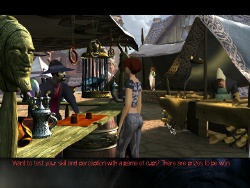 For
example, most people would consider the following to be an overly contrived inventory-based puzzle: For
example, most people would consider the following to be an overly contrived inventory-based puzzle:
| Spoiler: |
| You have to retrieve a key from the subway tracks. You have a clamp and a clothesline
that can be combined into a makeshift fishing line, but this isn't good enough (April comments that it's not at
the correct height when you try to use it). So... you have to blow up a deflated rubber ducky, then combine it
with the clamp and clothesline in order to be able to get the key. As you would :- |
I did eventually get that one, but only after trying everything in my inventory. But there are other puzzles that
make up for that one, like this one:
| Spoiler: |
| On an island, you need to wake a sleeping giant named Q'aman. But April's gentle voice alone isn't
enough to get his attention, so we need to amplify it somehow. Using cues from the environment, you discover that you can rotate
the tops and bottoms of three statues to construct a crude acoustic amplifier/relay. Then when you speak into the base of the
statue at the beginning of the relay, you manage to wake the giant at the other end. |
The story in The Longest Journey was definitely the strongest feature of the game. The puzzles for the most part
were just a notch above average, though satisfying to solve.
As with The Longest Journey, Syberia is another game that deals with a life-changing
experience for a strong female protagonist, in this case Kate Walker. Again, the puzzles aren't world class, but they are a step up
from Sokal's previous effort, Amerzone (Second Opinion).
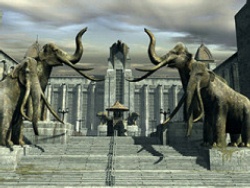 Hmm.
A perusal of my own Syberia walkthrough only turns up one puzzle that I remember as being somewhat inspired: Hmm.
A perusal of my own Syberia walkthrough only turns up one puzzle that I remember as being somewhat inspired:
| Spoiler: |
| Kate has to get a drunk cosmonaut launched into space, but the problem is that the launch console has
a built-in sobriety test, which you eventually circumvent by swapping Kate's blood sample with that of the inebriated cosmonaut's. |
Yes, it was definitely the story that carried Syberia, though the puzzles weren't bad by any measure, just adequate. There
was a very amusing bit when you discover that you need to repair a bandstand for the rectors of Barrockstadt University in return for a
certain favour, but this was more an example of good story-telling rather than being a case of anything special concerning the puzzle design.
I thought we were in for a real treat when this game first surfaced, for it looked all set to be a revival of the old cartoon
style adventures. But my hopes were soon dashed when I was forced to access a walkthrough twice in the first half hour
of play.
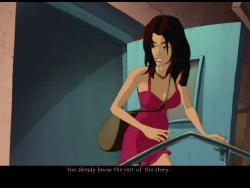 The
first instance was for an object I had missed: The
first instance was for an object I had missed:
| Spoiler: |
| You need to obtain an empty syringe from a storeroom. But the hotspot for it is one of the
smallest I've ever seen. It's no more than 3 or 4 pixels across, so you almost have to know what you're looking for! Without
the walkthrough, I'd never have found this item. |
Shortly after that, we have an artificial obstacle, in that unless you've performed a seemingly unnecessary action, you
can't complete a puzzle:
| Spoiler: |
| You figure out that you need to activate a sprinkler system in order to wake up the drugged woman you
are trying to rescue from hospital. But the game won't let you activate the sprinkler system (using two items you have acquired
that are obviously for this purpose) unless you first read a medical journal to find out that the only thing that will wake
up a person drugged with 'Snoozitol' is a cold shower. Sorry? I already figured the puzzle out, so let me solve it without leading
me by the nose, please! |
Then about a quarter of the way through the game, if that, a conversation begets object and conversation activates object within the
space of 5 minutes:
| Spoiler: |
| You've completely explored a museum, including one room that had nothing in it. Then after speaking to
someone who happens to mention coffee beans, a pot of same magically appears in that room where there was nothing before. There is
also an empty coffee wrapper in a wastebasket. But guess what? You aren't allowed to pick it up or interact with it in any way until
you talk to this person again to discover that you 'need' this item :- |
I quit the game right there and put it on the shelf. Sorry guys, but too many artificial obstacles for me. Talk about ruining your
suspension of disbelief! Here's what a day in the office would be like if you were playing by the Runaway rules:
I come into work, dying for that first cup of coffee. But I can't lift the coffee pot for some strange reason. So I call over a
colleague to show him this amazing phenomenon, and he remarks: "Steve, you didn't want that coffee badly enough." And now I can suddenly
pick up the coffee pot...
One of the biggest issues I had with this game was the controls - not exactly an issue that you would consider to be associated with
the quality of the puzzles, but when a large part of the game play involves having to run away from things (or sneak by them), it very quickly
becomes an issue that can spoil the whole experience for you. The problem was, specifically, that you would start running away from danger...
but then the camera angle would change, and you'd have to realise this and hit the cursor key corresponding to the complete opposite
direction. This is because the direction you needed to head in was with respect to the screen instead of the character! Anyway, enough
about that. The control scheme (that was obviously designed for consoles) and various other aspects of the game are discussed in our review
of Broken Sword: The Sleeping Dragon.
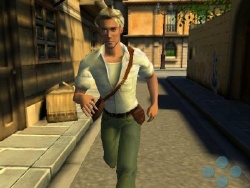 Puzzle-wise,
this game wasn't a patch on its venerable ancestor: Broken Sword: The Shadow of the Templars.
I won't be spoiling anything by telling you that at least 10 of the puzzles involve the pushing around of crates. If I want to do that
in a game, I'll play Sokoban, thank you very much! In fact, a large portion of the
'puzzles' are purely environmental, and involve figuring out how to climb up on ledges, sneak by guards, and so forth. So this game was
definitely dumbed down for the potential console audience, no doubt about it. And guess what? They didn't buy it either. It's pure action
they want. Puzzle-wise,
this game wasn't a patch on its venerable ancestor: Broken Sword: The Shadow of the Templars.
I won't be spoiling anything by telling you that at least 10 of the puzzles involve the pushing around of crates. If I want to do that
in a game, I'll play Sokoban, thank you very much! In fact, a large portion of the
'puzzles' are purely environmental, and involve figuring out how to climb up on ledges, sneak by guards, and so forth. So this game was
definitely dumbed down for the potential console audience, no doubt about it. And guess what? They didn't buy it either. It's pure action
they want.
Another game that was saved from oblivion only by a good story and extremely well executed cinematics.
This is a game that I picked up only because I intended reviewing it for Quandary. Fortunately, Gordon spared me that
endeavour (review of The Case of the Silver Earring) because I was so befuddled
by the poor inventory implementation that I gave up after a mere half hour of game play:
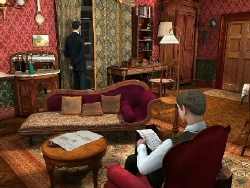
| Spoiler: |
| Early on in the game, through some very tedious pixel hunting, you have
managed to acquire three samples of 'white powder' in your inventory. But there's no way to tell them apart! You'd
think that the famous Holmes, the detective who practically defined 'meticulous', would be especially fastidious about
noting where each sample came from. A vital clue could be provided if the samples turned out to be different. As
it turns out from later reading a walkthrough, they happened to be all the same. But the game was already ruined for me,
and I gave up playing right then. |
The Case of the Silver Earring is guilty of a long dead end, as I also discovered by reading a walkthrough:
| Spoiler: |
| "...the game contains some sort of glitch which makes it possible for you to continue past the
first part of the game even if you neglect to pick up one of the items. This is really bad news, because you need that
particular item on the fourth day of the investigation, and if you don't have it, you can't proceed. So be very careful
when investigating Sherringford Hall! |
And a timed puzzle. From Gordon's review: "For me, however, the most frustrating 'puzzle' was the task of sneaking past a guard
and guard dog at night, not once, but twice. I swear that dog had X-Ray vision and night goggles as it seemed to unfailingly
spot me over large distances even when I positioned Holmes behind objects in its line of sight. Of course there is a knack to
avoiding it but I failed far too many times before I worked it out. This episode involved tedious repetition and trial and
error and it threatened to colour my perception of the whole game."
And finally, some annoying ambiguity: "I must confess I was held up for a time at the quizzes for two reasons.
Firstly, there are one or two ambiguous questions and, secondly, sometimes more than one piece of evidence could fit the answer and
you must choose the right one. Systematically changing my responses eventually got me through but I know that some players may
find this aspect to be quite frustrating. Especially as you can't continue with the game until each quiz is completed successfully
and there may be more than one question with more than one possible answer. The potential frustration level here could have been
lowered considerably by indicating which questions were correctly answered."
All in all, another shining example of "nice graphics, sorry about the game play" that seems to perfectly sum up the games made
by Frogwares. After that experience, and having read dismal reviews of most of their subsequent efforts, I can tell you that I'll
never play another game made by Frogwares.
I thought this game struck a good balance between abstract and practical puzzles. It also had a gritty realism about it that is
hard to come by in adventure games. In Still Life, you take turns playing as Victoria, a
detective in modern Chicago, and her grandfather Gustav in late 1920's Prague. There's a serial killer loose in both epochs, and
the similarities between the two cases eventually can't be dismissed as mere coincidence...
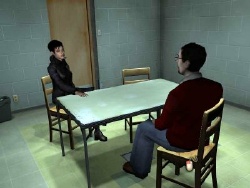 One
puzzle that I'm certain got nearly everyone's goat, including mine, involved baking cookies from an ambiguous recipe. It was out
of context, and only served to slow down the game pacing at a time when things were just beginning to pick up. On the upside,
however, was a practical lockpicking puzzle that was very rewarding to figure out... if you managed to stick with it that is.
A lot of people probably lack the patience for this sort of puzzle. But as you can gather from the thrust of these articles, I
maintain that complex puzzles with clearly defined goals are the mainstay of adventure games. Aside from the story lines, that's
why I play them anyway. One
puzzle that I'm certain got nearly everyone's goat, including mine, involved baking cookies from an ambiguous recipe. It was out
of context, and only served to slow down the game pacing at a time when things were just beginning to pick up. On the upside,
however, was a practical lockpicking puzzle that was very rewarding to figure out... if you managed to stick with it that is.
A lot of people probably lack the patience for this sort of puzzle. But as you can gather from the thrust of these articles, I
maintain that complex puzzles with clearly defined goals are the mainstay of adventure games. Aside from the story lines, that's
why I play them anyway.
And finally, we have one of the most ingeniously constructed practical puzzles I can remember in a long time:
| Spoiler: |
| You have to guide a remotely-controlled spider robot through a room that is laced by deadly lasers.
There's no denying that this is a timed puzzle, and a very difficult one. But there's an infinite amount of spider bots at
your disposal, so practice makes perfect. The trick to solving it is that you can pause to think at certain 'safe spots' on
the walls of the room. You observe how the lasers move, and plot the series of moves to get you to the next safe spot. Took
me nearly two hours to crack it, but the feeling of accomplishment I got was second to none! |
All things considered, Still Life would be one of my favourite games of the new millennium.
If looks were everything, then Wicked Studios would have had a real winner in Keepsake.
The graphics featured some of the best background detail work I've ever seen. However... I'm sure the designers tried very
hard to make a series of compelling abstract puzzles to go along with the pretty pictures, but they largely didn't succeed in this
respect.
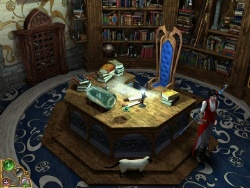 For
example, you need to hook up 16 scrambled pictures of gears in order to make a working gearbox: For
example, you need to hook up 16 scrambled pictures of gears in order to make a working gearbox:
| Spoiler: |
| But for no less than 4 of the pieces, it's ambiguous as to where they might be placed, since
they don't have any parts of gears on them! Two walkthroughs proposed two different solutions, only one of which worked
in the end. |
Then there was an astronomy 'puzzle', where you had to use a strange telescope to pick out a series of constellations, going
by some rather tenuous clues that I never quite managed to figure out. The walkthrough writer couldn't figure it out either. Quote:
"ask the hint system because this puzzle is very complex!"
That's just a sampling from about 20 puzzles that I thought were pretty weak. In Keepsake, you can get the puzzles to
solve themselves, but that's really an apologist solution for the dodgy puzzle design. What it all boils down to is that
Keepsake is for the most part choc full of twiddleware. No thanks.
A lot of people seemingly didn't like this game, but I thought Secret Files: Tunguska was
a pretty solid attempt to return to the roots of the genre: an adventure with almost exclusively inventory-based puzzles. The
following was a particularly good puzzle:
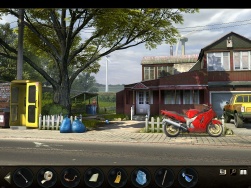 Nurse
Sabrina (by now you must think I have a nurse fixation. Or is it the game designers? ;-) is dancing behind the reception desk at the
clinic, to some upbeat Latin music. A painter sitting outside the clinic wants to do a picture of her, but can't
because she's moving back and forth in front of the window too quickly. So you have to: Nurse
Sabrina (by now you must think I have a nurse fixation. Or is it the game designers? ;-) is dancing behind the reception desk at the
clinic, to some upbeat Latin music. A painter sitting outside the clinic wants to do a picture of her, but can't
because she's moving back and forth in front of the window too quickly. So you have to:
| Spoiler: |
| Put a weight on the turntable that is playing the music to slow it down. Nurse Sabrina now dances
slowly in front of the clinic window, and the painter gets his portrait. |
Admittedly though, there were some McGyver-like puzzles that stretched the imagination a bit:
You're at a house, and through a back window you observe someone talking on a phone in the kitchen. This person has just
slammed the front door in your face, and you want to eavesdrop on the phone conversation, because you know it has something to
do with your visit to the house:
| Spoiler: |
| There's a cat on the front porch, and a feeding dish. You need to put a slice of pizza in the dish, then
the critter is sufficiently distracted so that you can attach your mobile phone to its back with double-sided tape. Then you
need to sprinkle salt on the pizza to make it thirsty, so it runs inside to get a drink from its dish in the kitchen, where
your mobile phone records the conversation. Then you ring your mobile from a phone booth in front of the house to scare the cat
into running out of the house so you can retrieve the mobile. Admittedly a bit far fetched, but I did figure this one out. The
clue was that through the back window, you could see the cat's water dish in the kitchen. |
I did enjoy this puzzle though. It's similar to the one in Gabriel Knight 3 involving the Mosely disguise
that we covered in Part I. Not entirely plausible, but there are sufficient hints provided by the game environment to aid you
in solving it.
Now, this was a 5-star game for me. And that does go to show that puzzles aren't the be-all and end-all, once the story is
good enough to suck you in all by itself. Dreamfall, the long awaited sequel to 2000's
The Longest Journey, features a new female protagonist, Zoe Castillo. But key figures from the original game, like April
Ryan, Brian Westhouse, and last but not least, Crow... also make an appearance.
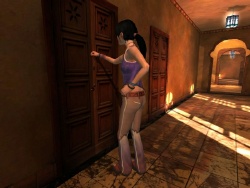 As
with Broken Sword: The Sleeping Dragon, a lot of the puzzles in Dreamfall are of a practical nature. Fortunately, no crate
pushing tediousness rears its ugly head here, but the challenges are not too inspiring to say the least. Aside from one fairly
decent abstract lockpicking puzzle that involved three interconnecting wheels, the rest of these are timed pattern matching puzzles. As
with Broken Sword: The Sleeping Dragon, a lot of the puzzles in Dreamfall are of a practical nature. Fortunately, no crate
pushing tediousness rears its ugly head here, but the challenges are not too inspiring to say the least. Aside from one fairly
decent abstract lockpicking puzzle that involved three interconnecting wheels, the rest of these are timed pattern matching puzzles.
There are also a good number of fighting sequences in Dreamfall with controls that are inadequate for the task (at least, on the
PC they were. Can't speak for the consoles). And also a few of the by now ubiquitous sneaking puzzles.
So in the end, Dreamfall somehow manages to creep into the top 5 on my list of favourite adventure games, but that's solely due to the
incredibly well realised story line and dialogue.
You'd think it'd be difficult to top indy developer Jonathan Boakes' first foray into the realm of ghost hunting adventures, the very
scary Dark Fall: The Journal. Yet the recently released The
Lost Crown makes a pretty good job of it. In The Lost Crown you take on the role of Nigel Danvers, a man on the run by virtue
of having stolen some top secret stuff from his employer, an imposing figure named Hadden. Nigel takes the last train from London to a
remote East Anglian town named Saxton, and there becomes caught up in a complex tale involving a long lost treasure.
 I'm
rating the puzzles in The Lost Crown as Good, but it's leaning towards just above Average. There are a few time wasters in there,
as in looking for letters to put on a headstone, and searching for plant varieties at night in the same location; however, these low
points are offset by a few solid puzzles that were quite pleasurable to solve, like: I'm
rating the puzzles in The Lost Crown as Good, but it's leaning towards just above Average. There are a few time wasters in there,
as in looking for letters to put on a headstone, and searching for plant varieties at night in the same location; however, these low
points are offset by a few solid puzzles that were quite pleasurable to solve, like:
| Spoiler: |
| You need to align three large millstones in a certain manner that allows Nigel to spot a church tower through
holes in the top of each stone. To do this, you have to learn what the symbols for the four seasons were in medieval times, and also
what order they occurred in, as the order differed back then from what it is today. |
There was another good puzzle towards the end, involving 5 stone discs, that at first glance seemed to be twiddleware. But it turns
out there is a mathematical solution:
| Spoiler: |
| You have to align 5 stone discs so that the 4 symbols on the middle disc line up with those on the 4
outer discs. Turning any of the outer discs causes the middle disk to turn as well. By playing a bit with the puzzle, you note
that it resets itself after you make any 5 moves. Therefore, all you need do is figure out where the middle disc winds up after
5 moves of the outer discs, and from there you can figure out how many times you need to rotate each outer disc so that the
symbols will align after 5 moves. |
So The Lost Crown was indeed a mixed bag, but there were enough solid puzzles (and a big creep-out factor thrown in!) to make
it a very worthwhile gaming experience.
Summing it all up
So why can't we have a good story AND solid, original puzzles to pace the story, like we did in the good ol' days? Remember: an
adventure is a story-telling puzzle game. I couldn't find a single game that I played in the past 8 years or so that I could hang a
puzzle rating of Excellent on, and that can't be a good thing. I'm also playing less adventure games lately because I read the reviews,
and therefore I know when they suck well beforehand... so I don't buy them. Modern adventure game designers seem to be
more concerned with the graphics, and less with the game play. Not exactly a trend that's going to help the revival of our favourite
genre, is it?
I don't imagine there's any magical cure for this malaise, nor am I going to be so presumptuous as to propose one... OK, twist my arm,
go on, go on, I will. What would help the most, I think, is if game designers would just revisit the classics and ponder over what it is
that made them great. That's all we're asking.
Copyright © Steve Metzler 2008.
All rights reserved.
|

